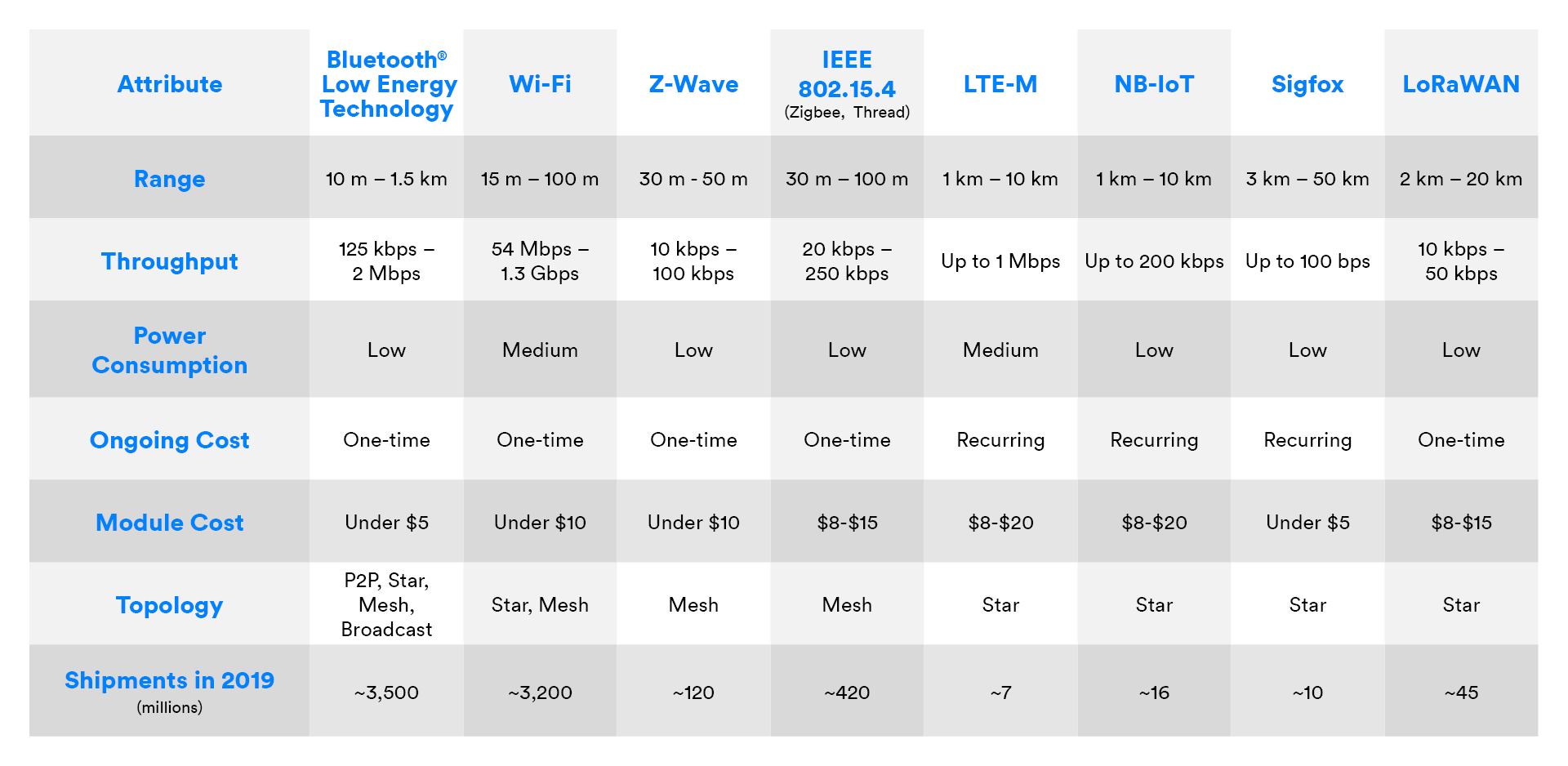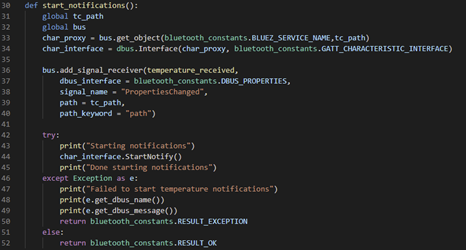In the previous post in the series, we talked about the fact that there’s no one-size-fits-all wireless connectivity solution for all projects. We also looked at the most popular IoT applications in the industrial and commercial space and listed the most important attributes and popular candidates relevant for these types of applications.

In this article, we’ll look at the different wireless connectivity technologies in a bit more detail and compare them in terms of the most important attributes applicable in the case of commercial and industrial IoT applications.
The technologies we’ll be comparing are:
- Bluetooth® Technology
- Wi-Fi
- IEEE 802.15.4-Based Technologies (Thread, Zigbee).
- Z-Wave
- Cellular Low-Power Wide Area Network Technologies (NB-IoT, LTE-M)
- Non-Cellular Low-Power Wide Area Network Technologies (LoRaWAN, Sigfox)
The attributes we’ll be comparing for each of the technologies are:
- Range
- Throughput
- Power consumption
- Cost
- Topology
Before we cover how these different technologies compare in terms of the attributes, let’s briefly introduce each technology. Going into detail for each of these technologies is out of scope for this article.
Bluetooth Technology
Definition
Bluetooth® technology is a low-power wireless solution that operates in the 2.4 GHz ISM band. It has expanded over the years and now provides tremendous flexibility in range, bandwidth, and communications topologies to address different IoT applications.
Technical Details
There are two different Bluetooth radio options: Bluetooth Classic and Bluetooth Low Energy (LE). Bluetooth Classic (or BR/EDR) is the original Bluetooth radio that’s still widely used in streaming applications, especially audio streaming. Bluetooth LE, on the other hand, has traditionally focused on low-bandwidth applications that involve infrequent data transmission between devices. Bluetooth LE is known for its very low power consumption and its proliferation in smartphones, tablets, and PCs.
Bluetooth LE provides the option to operate in point-to-point, star, mesh, and broadcast topologies. In a mesh topology, nodes connect directly to each other without the need to communicate with others through a central hub. This allows nodes to relay data and information to other nodes out of reach from the original source node, extending the reach of the network in a large area.
Primary Use Cases
Bluetooth LE is most popular in health and fitness devices, smart lighting systems, real-time location systems, and indoor navigation applications.
![]()
FEATURED TOOL
The Bluetooth Range Estimator
Calculate the expected range between two Bluetooth devices.
Wi-Fi
Definition
Wi-Fi is the trademark name for any Wireless Local Area Network (WLAN) that follows the IEEE 802.11 standard. It most commonly operates in the 2.4 and 5 GHz ISM Bands, but newer versions also target other frequency bands.
Technical Details
There are many variants of Wi-Fi, and the Wi-Fi Alliance has recently adopted a version numbering system: Wi-Fi 1 (802.11b), Wi-Fi 2 (802.11a), Wi-Fi 3 (802.11g), Wi-Fi 4 (802.11n), Wi-Fi 5 (802.11ac), and Wi-Fi 6 (802.11ax). More recently released versions were introduced to target different kinds of applications including longer range, higher throughput, and better coverage.
The most popular topology utilized in Wi-Fi is the star topology, in which nodes can only communicate with each other through a central hub.
Primary Use Cases
Wi-Fi is popular in applications involved with transferring large files and higher-bandwidth data transfer applications, such as video streaming.
In the case of IoT applications, Wi-Fi is most commonly used for devices that need a direct connection to the internet. However, it is not usually associated with low power consumption, and its use is limited in applications and devices that require running on small batteries for long periods of time.

IEEE 802.15.4-Based Technologies (Thread, Zigbee)
Definition
IEEE 802.15.4 technologies refer to the access layer for low-rate wireless personal area networks (LR-WPANs).
Technical Details
Thread and Zigbee are two different technologies built on top of this specification. They are characterized by their low power consumption and low data rates. IEEE 802.15.4 is used primarily for small amounts of data over a low range while maintaining low power consumption.
While a star topology is supported, the most popular topology utilized is the mesh topology.
Primary Use Cases
These technologies are most commonly used in wireless control and monitoring applications in the smart home space.
Z-Wave
Definition
Z-Wave started out as a protocol for controlling lighting systems and evolved into a home automation protocol managed by the Z-Wave Alliance.
Technical Details
It is a proprietary technology that operates in the 908/915 MHz band in the U.S. and 868 MHz in Europe. This is designed to avoid interference with the 2.4 GHz ISM band and extend coverage.
The primary topology utilized is the mesh topology.
Primary Use Cases
This technology’s main use is in smart home applications.
![]()
Cellular Low-Power Wide Area Network Technologies (NB-IoT, LTE-M)
Definition
LTE-M (LTE Cat-M1, or Long-Term Evolution for Machines) and NB-IoT (NarrowBand IoT) are both technology standards developed by 3GPP (3rd Generation Partnership Project) as cellular-based technology solutions for IoT applications.
These two technologies are poised as an integral part of the long-term 5G IoT strategy by allowing them to co-exist with other 5G technologies. 5G is the overarching term used to describe the fifth generation of cellular technology. It promises high speeds of 2 Gbps (and even up to 100 Gbps in the future). 5G technologies also promise reduced latency and wider coverage (in terms of the number of devices concurrently connected to a network).
Technical Details
LTE-M and NB-IoT differ in several attributes that make each of them suitable for different types of applications.
NB-IoT is ideal for simple applications with low power consumption and low bandwidth requirements, while LTE-M has a higher data rate and is best suited for real-time and mission-critical applications. The main differences between the two are speed (higher for LTE-M) and latency (lower for LTE-M).
NB-IoT and LTE-M operate primarily by design in a star topology.
Primary Use Cases
The main use cases of NB-IoT include smart agriculture, smart city, and smart meter applications. The main use cases of LTE-M, on the other hand, include logistics, healthcare devices as a backhaul communications channel, and in automotive applications.

Non-Cellular Low-Power Wide Area Network Technologies (LoRaWAN, Sigfox)
Definition
LoRaWAN is an open wireless networking protocol maintained by the LoRa Alliance. LoRaWAN is built on top of LoRa, a proprietary modulation format developed by a company called Semtech.
Technical Details
LoRa only defines the lower-level layers of the network stack, and LoRaWAN defines the upper layers of the stack. LoRaWAN is simply one of several protocols built on top of LoRa.
LoRaWAN is categorized as a low-power wide-area network (LPWAN) technology. It enables long-range communication between devices while maintaining low-power consumption.
Sigfox is also an LPWAN technology, however, it’s a proprietary technology that’s offered by the French company Sigfox, which acts as the sole network operator for the technology.
Primary Use Cases
LoRaWAN is popular in smart city applications, such as smart utility meters, smart parking meters, and supply chain and logistics applications like asset tracking. Sigfox is also popular in smart city applications but more so in the EU region than in the U.S.
Comparison Table
In the following table, we compare the different wireless technologies mentioned previously.

In the subsequent articles within the series, we will cover a wide variety of industrial applications, list the most important attributes for each application, and assess the most suitable technologies for that application.
![]()
STAY INFORMED
Bluetooth Email Updates
Stay up-to-date on what’s new with Bluetooth, and get the resources you care about, from newly released papers and case studies to developer study guides, videos, and more. Subscribe to receive timely, relevant emails that won’t overfill your inbox.






























